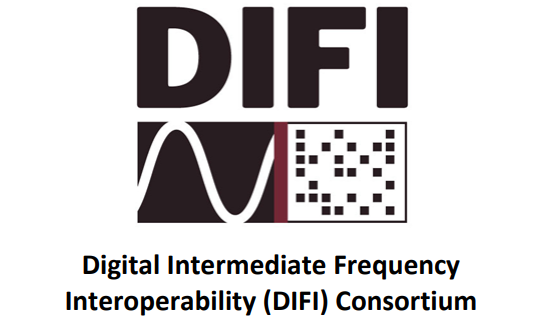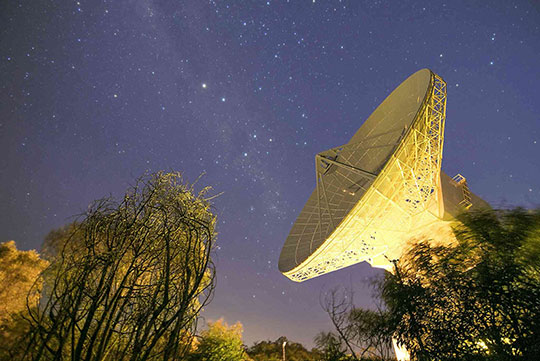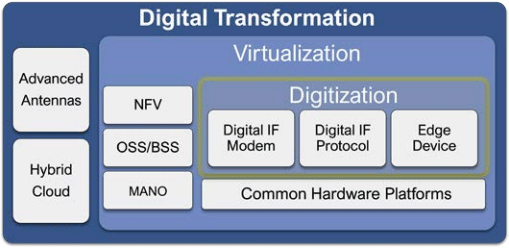 DIFI Logo. Credit: DIFI Consortium
DIFI Logo. Credit: DIFI Consortium
WASHINGTON — The Digital Intermediate Frequency Interoperability (DIFI) Consortium recently published updated specifications for interoperable digital IF/RF marking a significant milestone in the digital transformation of the satellite and space industries.
The IEEE-ISTO Std 4900-2021: Digital IF Interoperability 1.1 Standard provides a framework for packaging and transmitting digital IF data packets in anticipation of increased digitization of the ground segment. The changes from the original specification reflect practical industry experience, testing and implementation.
“This is really a maturation of the standard,” said DIFI chair and SVP of Advanced Technology at Kratos Stuart Daughtridge. “This new standard is the result of a much broader review with input from all parts of the industry.”
The new standard was peer reviewed by DIFI members and passed with unanimous approval from the board of directors and voting members.
The level of engagement from leading satellite operators, terminal suppliers and government agencies is a promising sign for the future of the DIFI standard. Since it was founded in September 2021, the consortium has grown from just six founding members to more than 50 industry and government leaders driving the development of a usable, open standard that will support the transition to a digital ground segment.
“I’m convinced, with this manpower in DIFI, this change is going to happen,” said Jörg Rockstroh, Director of Business Development and Digital Products at WORK Microwave, an early member of DIFI. “[Digital IF] is a huge technological step ahead. You don’t have that every year or every three years. It’s only every decade or so. That’s a really exciting thing to participate in.”
Unleashed from the ‘Coaxial Copper Cable World’
DIFI members were enthusiastic about how the standard will support new capabilities that were not possible with analog signals. Load balancing across multiple facilities, flexible routing, sending RF signals anywhere with zero loss of signal quality are among the applications of digitized signals over Ethernet or Wide Area Networks. Operators will have much more choice about where they locate assets, with antennas built at an ideal site for reception and the signal processed at another.
 The 35 m-diameter dish antenna of ESA’s deep-space tracking station at New Norcia, Australia, illuminated by ground lights against the night sky. Credit: ESA
The 35 m-diameter dish antenna of ESA’s deep-space tracking station at New Norcia, Australia, illuminated by ground lights against the night sky. Credit: ESA
“Once you get your head around what digital IF is and what it can do for the satellite community, it opens your mind up to the things that you literally cannot do in the old, analog, coaxial copper cable world,” said Mark Jasen, President of the Genus Group.
The industry is still in a relatively early stage with only a handful of companies offering commercial or dual-use RF over IP capabilities. That is expected to change soon. Industry insiders are following at least a dozen companies at the development-phase with plans to bring new capabilities to the market in the coming years. The applications are also coming at a time when bandwidth costs are on a steady decline and cloud computing has become more affordable.
Evolving Standards
The DIFI standard was built on VITA 49.2, a protocol that evolved out of the DoD in the early 2000s to define packet structures for digitized IF signals and metadata. The framework was useful, however, VITA 49 fell short of its goal: interoperability. Ultimately, the parameters were too flexible. Companies that were VITA 49 compliant on paper couldn’t exchange data.
“We didn’t need to reinvent the wheel,” explained Daughtridge. “Most of the satellite industry was already using VITA 49. What we needed to do was lock it down, take away the flexibility—and we did that. So, if you’re DIFI compliant you will, by definition, be able to send and receive packets from anybody else who is DIFI compliant.”
 Two Major Components of This Digital Transformation Are Digitization and Virtualization. Credit: CSIAC
Two Major Components of This Digital Transformation Are Digitization and Virtualization. Credit: CSIAC
A handful of DIFI members are already compliant with the 1.1 specification. Others are moving in that direction. The updated standard covers data plane implementation and defines a specific way for packing IF/RF information into IP packets.
Interoperability remains a critical shared interest of both government and commercial players in establishing a digital IF standard. Vendor lock-in remains an issue for the satellite industry and military acquisitions with a handful of vertically integrated companies dominating the landscape. At the same time, the supply chain disruptions of the past two years have highlighted the need for a diverse, competitive and resilient industrial base.
“No one company is going to solve all the problems,” Jasen emphasized. “We need the entire community to build capability. Then we compete and leverage the best and the brightest, not because it’s the equipment I already have but because it brings me to another level.”
